Bourke Ulick J. Aryan Origin of the Gaelic Race and Language
Подождите немного. Документ загружается.

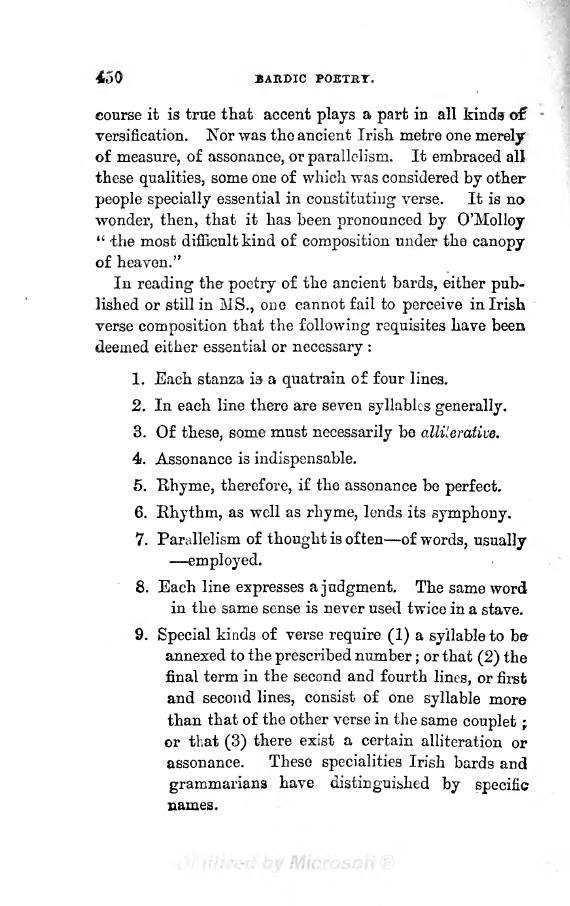
450
BARDIC POETET.
course
it is true that accent
plays
a
part
in all
kinda
of
versification.
Nor was the ancient Irish
metre
one
merely
of
measure,
of
assonance,
or
parallelism.
It
embraced all
these
qualities,
some
one of which
was considered
by
other
people specially
essential
in
constituting
verse. It is
no
wonder,
then,
that it
has
been
pronounced
by
O'Molloy
"
the most difficult
kind of
composition
under the
canopy
of heaven."
In
reading
the
poetry
of
the ancient
bards,
either
pub-
lished or
still
in
MS.,
one
cannot
fail to
perceive
in
Irish
verse
composition
that the
following
requisites
have been
deemed
either essential
or
necessary
:
1. .Each stanza
is a
quatrain
of four
lines.
2.
In each
line
there are
seven
syllables
generally.
3.
Of
these,
some
must
necessarily
be
allilerative.
4.
Assonance
is
indispensable.
5.
"Rhyme,
therefore,
if the
assonance be
perfect.
6.
Rhythm,
as well
as
rhyme,
lends
its
symphony.
7.
Parallelism
of
thought
is
often
of
words,
usually
employed.
8.
Each
line
expresses
a
judgment.
The
same word
in
the
same sense is never
used
twice in
a
stave.
9.
Special
kinds
of
verse
require
(1)
a
syllable
to b&
annexed
to the
prescribed
number
;
or
that
(2)
the
final
term
in the second and
fourth
lines,
or
first
and
second
lines,
consist
of one
syllable
more
than
that
of
the other verse in
the
same
couplet
or
that
(3)
there
exist
a
certain
alliteration
or
assonance.
These
specialities
Irish
bards
and
grammarians
have
distinguished
by
specific
names.
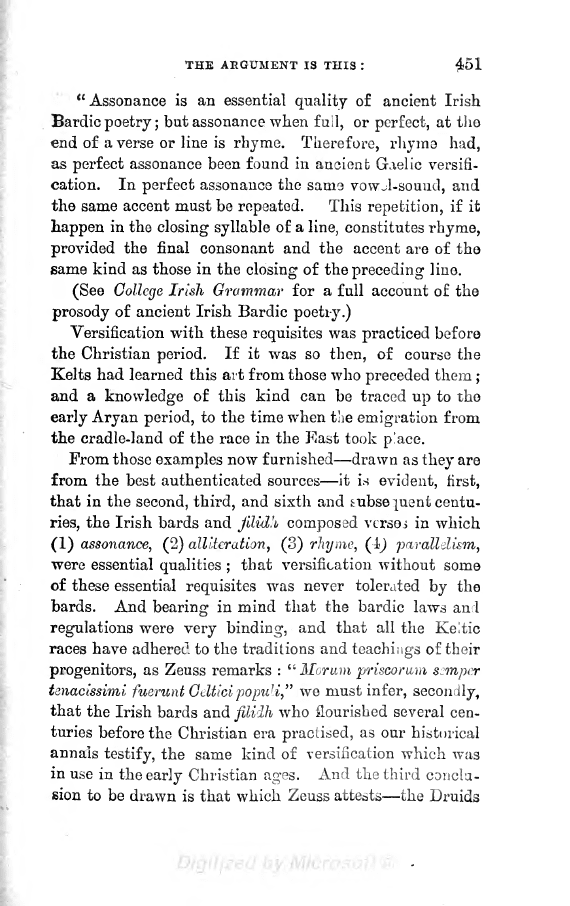
THE ARGUMENT IS
THIS : 451
"
Assonance is
an
essential
quality
of
ancient Irish
Bardic
poetry
;
but
assonance
when
fuil,
or
perfect,
at
tho
end of
a
verse or line
is
rhyme.
Therefore,
rhyme
had,
as
perfect
assonance been
found in
ancient
Gaelic versifi-
cation. In
perfect
assonance
the
same
vow^l-souncl,
and
the
same
accent
must be
repeated.
This
repetition,
if
it
happen
in
the
closing
syllable
of
a
line,
constitutes
rhyme,
provided
the final
consonant
and
the
accent are of
the
same
kind as those in the
closing
of the
preceding
line.
(See College
Irish
Grammar
for a full
account of the
prosody
of
ancient Irish Bardic
poeti-y.)
Versification with these
requisites
was
practiced
before
the
Christian
period.
If it
was so
then,
of
course
the
Kelts
had
learned this
art from
those
who
preceded
them
;
and a
knowledge
of
this
kind
can
be traced
up
to
tho
early Aryan period,
to the
time when
the
emigration
from
the
cradle-land
of the
race
in the
East took
place.
From
those
examples
now furnished
drawn
as
they
are
from the best authenticated sources
it i,->
evident,
first,
that in
the
second,
third,
and sixth and
&ubse|uent
centu-
ries,
the
Irish
bards
and
Jilidlt, composed
versos in
which
(1)
assonance,
(2)
alliteration,
(3)
rhyme,
(4i)
paralldism,
were
essential
qualities
;
that
versification
without
some
of
these
essential
requisites
was never
tolerated
by
the
bards.
And
bearing
in
mind
that
the
bardic
laws
and
regulations
were
very
binding,
and
that all
the
Keltic
races
have adherec
1
to the
traditions
and
teachings
of their
progenitors,
as
Zeuss remarks
:
"
Morum
priscorum
ssmper
tenacissimi
fueruntCelticipopuli,"
we
must
infer,
secondly,
that
the
Irish
bards
and
filidh
who
flourished several
cen-
turies
before
the
Christian
era
practised,
as
our
historical
annals
testify,
the same
kind
of
versification
which
was
in
use
in
the
early
Christian
ages.
And
the
third
conclu-
sion
to
be
drawn
is
that which Zeuss
attests the
Druids

r!
2
RHYME
FROM THE
GAELS,
NOT FROM THE
ARABS,
and
bards
of Wales
and Gaul
practised
the
same
kind
of
Tersification
in
which
the bards
and
filiclh
of
Eire com-
posed
their
hymns
and
elegies.
.
.
.
Another inference
is
this,
that the
Keltic
inhabitants of
Gaul,
Cambria,
and
Eire
knew
enough
about
rhyme
and its use
;
that Keltic
bards
of
Eire and Gaul
put
that
knowledge
into
practice
2,000
years
before
the Saracsns came
to
enlighten
Europe.
These views receive
authoritative
force from
the words
of
the
learned scholar
and
critic,
Rev. Edward
Davies,
Chancellor,
at
one
time,
of
Christ's
Church, Srecon,
Cam-
bria.
It
is admitted
in
all
quarters
with S.
Turner,
the
historian,
and
Matthew
Arnold shows
the fact
clearly,
that
the Cambro-Britons
have considerable
remains of
poetry
preserved
since
the
sixth
century.
"
Whom,
then,"
asks
Davies,
"
should
the
bards
of
the
sixth
century
have
imitated
but
their
predecessors,
in their
own
country,
and
who
had
composed
in their
own
language
? What
had
they
to do with the Saracens ?
Nothing.
"And
he adds:
"Or
with
the monks
of
Italy
?"
Had h,3
known the
history
of
hymnology
fully
at that
time,
he
would not ask this
last
question
;
for
the monks of
Italy
had,
at the
time,
actua'.ly
acquired
from the
Kelts
the
knowledge
and the
style
of
writing
those
hymns
sung
by
the
Church
from the
time
of St.
Ambrose
and St.
Augustine.
"
Had not
suffi-
cient
proofs
been
adduced,"
he
asks
again,
"
that
rhyme
was
generally
known
in
Europe
as
early
as the
first
century
of
our era ?
Yet,
it was
specially
known
to
the
Kelts,
among
whom
we
find
it in full
establishment."
KHYME,
NOT
FROM ARABIA.
The conclusion
to
be drawn as certain
from
the
facts
now
known
is,
that
rhymo
in
modern
European
poetry
has
not
had
its
origin
in Arabic
or
Saracen literature
;
not
in
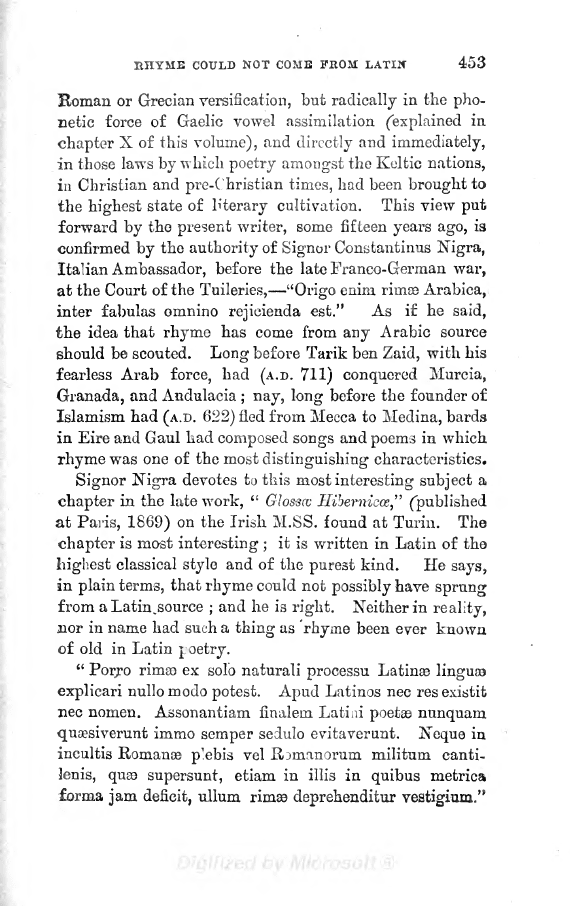
HHYMB
COULD
NOT COME
FROM LATIHT
453
Boman
or
Grecian
versification,
but
radically
in
the
pho-
netic
force of
Gaelic
vowel assimilation
(explained
in
chapter
X
of
this
volume),
and
directly
and
immediately,
in those
laws
by
which
poetry
amongst
the Keltic
nations,
in
Christian
and
pre-Christian
times,
had
been
brought
to
the
highest
state
of
literary
cultivation.
This view
put
forward
by
the
present
writer,
some
fifteen
years
ago,
is
confirmed
by
the
authority
of
Signer
Constantinus
Nigra,
Italian
Ambassador,
before the
late
Franco-German
war,
at
the Court
of
the
Tuileries,
"Origo
enim
rinia3
Arabica,.
inter
fabulas
omnino
rejicienda
est." As
if he
said,
the
idea
that
rhyme
has come from
any
Arabic
source
should
be
scouted.
Long
before
Tarik ben
Zaid,
with
his
fearless Arab
force,
had
(A.D.
711)
conquered
Murcia,
Granada,
and Andulacia
;
nay, long
before
the
founder
of
Islamism
had
(A.D.
622)
fled from
Mecca
to
Medina,
bards
in
Eire
and Gaul
had
composed
songs
and
poems
in which
rhyme
was
one of the
most
distinguishing
characteristics.
Signer
Nigra
devotes to this
most
interesting subject
a
chapter
in the late
work,
"
Glosscc
Hibernicce,"
(published
at
Paris,
1869)
on the Irish
M.SS.
found at
Turin. The
chapter
is most
interesting
;
it
is
written in
Latin
of the
highest
classical
style
and of the
purest
kind. He
says,
in
plain
terms,
that
rhyme
could not
possibly
have
sprung
from
a
Latin,
source
;
and
he
is
right.
Neither
in
reality,
nor in
name had such
a
thing
as
rhyme
been
ever known
of
old in Latin
poetry.
"
Porro
rimse ex
solo natural
i
processu
Latinse
linguse
explicari
nullo
modo
potest. Apud
Latinos nee
res
existit
nee
nomen. Assonantiam finalem
Latini
poeta3
nunquam
qusesiverunt
immo
semper
sedulo evitaverunt.
Neque
in
incultis
Romanes
p'.ebis
vel
Eomanorum milituin
canti-
lenis,
qua9
supersunt,
etiam
in illis in
quibus
metrica
forma
jam
deficit,
ullum
rima3
deprehenditur
vestigium."
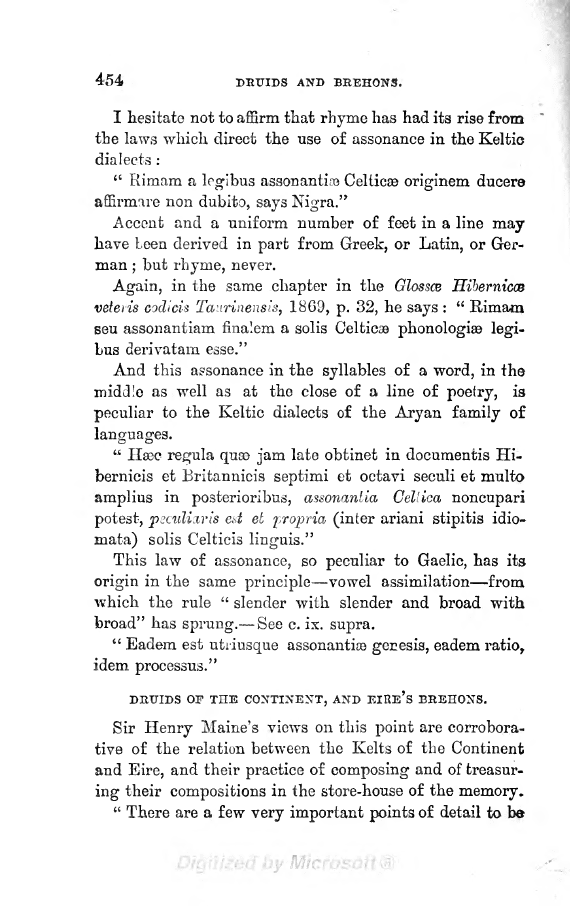
454
DRTJIDS
AND
BREHONS.
I
hesitate
not to
affirm
that
rhyme
has had
its
rise from
the
laws
which direct the
use
of assonance in
the
Keltic
dialects
:
"
Rimam a
legibus
assonantice
Celticae
originem
ducere
affirimre
non
dubito,
says Nigra."
Accent
and a
uniform number of feet
in
a line
may
have been
derived
in
part
from
Greek,
or
Latin,
or
Ger-
man
;
but
rhyme,
never.
Again,
in
the same
chapter
in
the
Glossce
Hibernian
vetens
codicis
Taurinensis, 1869,
p.
32,
he
says
:
"
Rimam
seu
assonantiam
finalem
a solis Celticse
phonologiaa legi-
bus
derivatana
esse."
And this assonance in the
syllables
of a
word,
in
the
middle
as well as at the
close
of
a
line of
poetry,
is
peculiar
to the Keltic
dialects of the
Aryan family
of
languages.
"
Ha3C
regula
qua3
jam
late
obtinet
in
documentis Hi-
bernicis
et Britannicis
septimi
et octavi seculi et
multo
amplius
in
posterioribus,
assonanlia Celiica
noncupari
potest,
peculiaris
est
et
propria (inter
ariani
stipitis
idio-
mata)
solis
Celticis
linguis."
This law
of
assonance,
so
peculiar
to
Gaelic,
has
its
origin
in the
same
principle
vowel
assimilation
from
which
the
rule
"
slender with
slender and
broad with
broad"
has
sprung.
See
c.
ix.
supra.
"
Eadem
est
ntriusque
assonantise
geresis,
eadem
ratio,
idem
processus."
DRUIDS
OF THE
CONTINENT,
AND EIRE'S BREHONS.
Sir
Henry
Maine's
views on this
point
are
corrobora-
tive
of the relation between
the Kelts
of the
Continent
and
Eire,
and their
practice
of
composing
and of
treasur-
ing
their
compositions
in the store-house
of the
memory.
"
There are
a
few
very
important points
of detail
to
be

HOW THEY DIFFER.
455
aiottced
in
Caesar's
description
of
what
may
be
called
tha
lay portion
of Keltic
society.
...
He
tells us
that
the
Druids were
supreme
judges
in
all
public
and
private
disputes,
and
that
all
questions
were referred
to
them.."
The same
tendencies
which
produced among
the
Kelts
of
the Continent
the class called
the
Dntids,
produced
among
the
Kelts of Ireland the class known
to us
as the
Brehons,
in
this
way.
The
Tribe-Chief,
or
King,
whom
the
earliest
Aryan
records
show
us
standing
by
the
side
of the
popular
as-
sembly,
was Priest
and
Judge,
as
well as
King,
that
is
head
or
captain
of the
host. The
later
Aryan
history
.shows
us
this blended
authority
distributing,
or
differ-
entiating
itself
and
passing
either to the
assembly
or to a
new
class
of
depositories.
Among
the
Acheans
of
Homer,
the
chief
has ceased
to
be
priest,
but
he
is
still
judge.
Among
the
Kelts,
both
of Gaul and of
Ireland,
he
has
ceased
to
be
priest,
and
almost ceased to
be
judge.
In
Athenian
history
the
institution of
Kingship
survived
only
in
the name
King
Archon,
or
Judge-King,
and
in
Roman
history
in
priest-king
"
Rex
Sacrificulus."
The difference between
the
Druids
and their
successors,
the
Brehons,
would
then
be
mainly
this
:
The
Brehon*
would be
no
longer
priests.
Kings
have
delegated
their
authority
to
judge
to
the
Brehons,
or
authors of
judgment,
But
the
literary
character
of the Druid and
judge
re-
mained
unchanged.
The Druid on
tbe
Continent,
and
the
judge
or
Brehon in
Ireland
presided
over
the
national
literary
life
of
the
country.
The
Druids
presided
over schools
of
learning,
to which
the
Keltic
youth
flocked
eagerly
for
instruction,
remain-
ing,
as
Cassar
tells,
u
in their
schools
for
twenty
years."
Pupils
learned
an
enormous
quantity
of
verses,
which
ihey
never
committed
to
writing,
and the
object
of
this,
it

456
LITEBABY
GUIDES.
seems,
was not
merely
to
prevent
sacred
knowledge
from
being
popularised,
but to
strengthen
the
memory,
and to
fit the scholar for
the
post
of
OUamh,
or
judge,
or
Druid.
fCassar
de
Eello
Gallico,
liber
vi.,
c.
13,
14.)
In
Caesar's
account
of
the
Druids there
is not
a
word,
says
Maine,
that
is
not
perfectly
credible. The
Kelts
of the
Con-
tinent
were before
all
things
remarkable
for the
literary
class
which
their
society
included.
Now,
the
schools of
literature and
law
appear
to have been
numerous
in
ancient
Ireland,
and
0'
Curry gives
the
course of instruction
in
one
of
them,
extending
over the
space
of twelve
years.
The
chief Druid of
Ca?sar meets
us on the
very
threshold
of the
Senachus
Mor,
in
the
person
of Dubhtach
Mac na
Lugair,
the
Royal poet
of
Erinn the Brehon who
was
chosen
by
St.
Patrick to arbitrate
in a
question
of homi-
cide,
and
whose
mouth the Saint blessed.
The
preface
of
the
Senachus
Mor
actually
contains
disquisitions
on all
the
matters
which Csesar declares
the Druids to have
been
specially
fond
of
arguing.
It sets
forth
how God
made
the Heavens
and
the Earth. It
goes
off,
as
Caesar's
Druids
did,
into a number
of
extraordinary
statements*
"
de
sideribiLs
atyue
eorvm
motu;
de mundi
ac
terramm
vnacjnUudine."
The Irish
Brehon
was,' therefore,
in
the
literary
world,
amongst
the Gaels of
Ireland,
what the
Druid
was on
the
Continent of
Europe.
His
style
of
teaching,
and
the
instructions he
imparted,
and
the
form
of
language
in which
he
required
his
pupils
to commit
these instructions
to
memory,
were the
same.
And this
conclusion
is
confirmed
by
the
authority
of
Zeuss.
Further
Maine
states,
it
is
r.ow
generally
agreed
that
the
volumnious
Sanscrit
literature in
verse
which
embraces
the
poetry
and most of the
religion
of the Hin-
doos,
and much of what stands
to them in
place
of
history
and
law,
was
originally
preserved
by
recollection
and
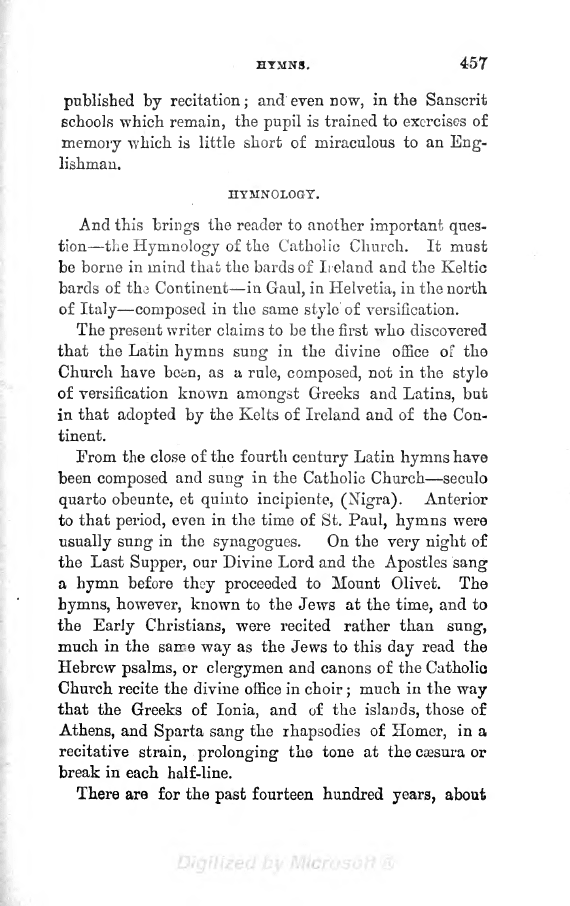
HYMNS. 457
published by
recitation;
and
even
now,
in the Sanscrit
schools which
remain,
the
pupil
is
trained to
exercises
of
memory
which
is
little short of miraculous
to
an
Eng-
lishman.
HYMNOLOGT.
And this
brings
the
reader to
another
important
ques-
tion
the
Hymnology
of the
Catholic
Church.
It
must
be borne
in mind that
the
bards of Ireland
and
the
Keltic
bards
of the Continent
in
Gaul,
in
Helvetia,
in
the
north
of
Italy composed
in
the
same
style
of
versification.
The
present
writer
claims
to be the
first who discovered
that the Latin
hymns
sung
in
the divine office
of
the
Church have
bebn,
as
a
rule,
composed,
not
in the
style
of
versification known
amongst
Greeks
and
Latins,
but
in
that
adopted by
the Kelts of
Ireland and of the
Con-
tinent.
From
the close of the fourth
century
Latin
hymns
have
been
composed
and
sung
in
the
Catholic
Church
seculo
quarto
obeunte,
et
quinto
incipienfce,
(Nigra).
Anterior
to
that
period,
even
in the
time of
St.
Paul,
hymns
were
usually sung
in the
synagogues.
On
the
very night
of
the
Last
Supper,
our
Divine
Lord and the
Apostles
sang
a
hymn
before
they
proceeded
to Mount
Olivet.
The
hymns,
however,
known to
the
Jews
at
the
time,
and
to
the
Early
Christians,
were recited
rather
than
sung,
much
in
the sarre
way
as
the
Jews to this
day
read the
Hebrew
psalms,
or
clergymen
and canons of
the
Catholic
Church recite
the divine
office
in
choir
;
much
in
the
way
that
the
Greeks of
Ionia,
and
of
the
islands,
those
of
Athens,
and
Sparta
sang
the
rhapsodies
of
Homer,
in
a
recitative
strain,
prolonging
the
tone
at
the caesura
or
break
in
each half-line.
There are
for the
past
fourteen
hundred
years,
about

458 IRISH POETS.
one hundred
and
fifty
Latin
hymns
in the
books of
devo-
tion
in use
amongst
the children
of
the Catholic
Church.
Nine
out of
ten
of
these
hymns
are written
in the
same
Btyle
as
that in
which the Irish
people
of
the
early period
wrote
their
native
"
dins." Of these
hymns
(1)
some are
composed
in
the
metre
of
the
poetic prototypes
according
to
which Horace
and Terence
wrote
(a)
Iambic
trimetre,
(6)
iambic
tetrametre,
(c)
sapphic,
with a
closing
adonic to
complete
the
strophl
Others
have
been
composed
irre-
spective
of the
laws
of
Latin
versification.
...
As
a
matter
of
fact,
however,
the
whole of this latter
class,
and
a
great
many
of
the
former,
are written
in
verses
of
the
same
number of
syllables,
and adorned with
the
same
phonetic
qualities
in which the bards
of Keltic
Gaul,
of
Cambria,
of
Eire,
composed.
H'ow account
for this
fact
?
The
hymnologists
must
.
.
. have
learned
of the
Keltic
bards,
or the Keltic bards
learned
of
them.
The
latter
part
of this
proposition
cannot be
admitted
chronology
and facts
are
against
it.
Again,
Zeuss
says,
this
form of
versifying
was
unknown
and
entirely
foreign
to
poets
of classical
antiquity.
THE WRITERS
OF
THE LATIN
HYMNS
WERE
IRISHMEN
OR
NATIVES
OF KELTIC
GAUL.
The
hymns
sung
in the
Church
prior
to
the
period
in
which
Urbam VIII.
flourished,
were
composed
either
by
(I)
Irishmen,
such
as
Sedulius, Columbanus,
Columba,
Secun-
diaus
;
or
(2)
by
men of
Keltic
origin,
as St.
Ambrose
;
(3)
or
those
who,
like St.
Augustine,
were
of the same
metrical
school
with St.
Ambrose;
or
lastly
(4)
those who
flourished between
the fourth
century
and the
fourteenth,
and
followed
in the
composition
of
hymns
the metre
and
melody
of
the
great
master
of
hymnology,
St.
Ambrose.
With
regard
to the
first,
they,
like
St
Fiach,
Bishop
of

BARDIC SONG
WEDDED TO CHURCH
MUSIC.
459
Sletty,
wrote
in
Irish
"dan
direac,"
and in
that
species
of
it
called
sc'adna,
which
contained
eight
syllables.
. .
For
men who
understood
Latin
so
well,
that
in
all
the
ancient
manuscripts
we
find
they
wrote
alternately
in
Latin
and
Iiish,
the
transition
from Irish
to Latin
versi-
fication
was
quite
natural and
easy.
When,
therefore,
one
finds
such
hymns
as those
which
an
Irishman,
Sedulius
composed
:
"A
soils
ortus
cardine,"
and
"
Hostis
Herodes
impie,"
written like the
Irish
odes of
the
time,
the
proof
is com-
plete
that that
manner of
composing hymns
was borrowed
from
the Irish
bards.
St.
Ambrose wrote
at
least
six
out of ten of
the
early
hymns,
so much
so that
hymns
were
styled
Ambrosiani.
"
Assonantia
finalis vel
rima,
seculo
quarto
obeunto
et
quinto
incipiente
vulgaris
sevi,
primum
occurrit
in
hymnis
Latinis ecclesiaa
modiolanensis
qui
Sancto
Ambrosio
et
Sancto
Augustino
tribuuntur.
Prima
itaque
rimao certa
exempla
iuveniuntur
in
solo
Celtico,
apud
Iticas
gentes,
in
carminibus
conditis
a
poetis
qui
vel
Celtics
originia
sunt,
vel
apud
Celticas
gentes
diu
commoraverunt."
The
conclusion
is
therefore certain
that it is
from the
lessons
of the
Irish
or
Keltic bards
that the
early
Latin
hymnologists
(natives
of
Ireland or Kelts of
.the
Conti-
nent)
imbibed
the
style
of
writing
hymns
and
sacred
poems.
A
great
school of
poets
of
this
class
sprung
up
in
the fifth
century,
the
sixth, seven,
and
eighth.
The
style
of
writing
these
hymns
became wedded
to
the
litera-
ture
of
the
Church,
just
as the metrical
songs
in
English
were
wedded,
by
Moore,
to the
genius
of
Irish
melody.
As
the
native
Irish
melodies
are
not
lost,
but
are
revived
in
a
new
phonology
English
surrounded
with
all
th
Q
